After Vientiane we were supposed to fly to Pakse, but since the airport of that town is closed in order to resurface the runway, we flew instead to Savannakhet, about 150 km further North. Not a real problem, but it meant 3 more hours of driving to get to our final destination, the Tat Fan National Protected Area (or NPA) and an Eco Lodge right on the edge of an escarpment, the Tad Fane Lodge. The claim to fame of the lodge is the best view of the Tat Fan Waterfall, one of the best in this area.
It is actually two waterfalls right next to each other, one smaller than the other. Remember, this is the dry season – I wonder what these are like at the end of the rainy season?
I went for a short walk to see if I could get a different viewpoint of the falls. I did not – it seems that the resort is at the only place where there is a reasonably clear view from the opposite side of the escarpment. However, I did discover that spring has other advantages, with beautiful violet flowers everywhere along the path.
As the sun started to go down, the reddish light metamorphosed the falls, gradually.
The effect get better and better with time
One the second day, we went for what was supposed to be an easy walk to view more water falls. It started easy enough as we went to another resort (I cannot remember the name) near another waterfall, for which I also forgot the name – I do have a photo, though!
The resort is very well integrated into the landscape and there is work going on to make it even more so.
That is when we made our mistake. We suggested to our local guide that it would be nice to be able to see the Tat Fan falls from above. The guide indicated that this could be done, and off we went. Going down to the falls was not very difficult.
On the opposite ridge, we can only guess at the eco lodge where we are staying.
Now we had to go back up towards the lodge. This is where things became a little more difficult. We encountered other, smaller falls on the way.
But the going was tough, at time, we had to do some rock climbing; at others, we were waist deep in tall grasses and low bushes that snared our ankles and scratched our legs. But in the end, we managed and were happy to get back to our rooms.
It was soon time to leave Tat Fan NPA and head back for the Mekhong, that would be the backbone of this whole trip. I had read in “the book” (once again for those who do not know, this is the Lonely Planet Guide) that there were very important Khmer ruins not far from Pakse called Wat Phu Champasak. I suggested to the group that we should make a detour there – Tuy, our leader, fortunately agreed even though it meant two additional crossings of the Mekhong and a three hour delay.
We did not know how perilous the crossing would be. The ferries themselves are not the most modern of crafts. IN addition, in order to get on the ferry, each vehicle had to ‘ride the planks’, narrow boards that were less than the width of the tires …
The ruins in question are contemporary to the high period at Angkor Wat. The main temple is very much in the model of Angkor, with one big difference: a stunning backdrop of steep mountains and sheer vertical cliffs.
Imagine water ponds on both sides of the causeway and this could be the main entrance to Angkor. There has been very little restoration here – the markers on both sides of the causeway are completely authentic.
You can get a better feel for the elevation difference of the site in this next picture.
The two buildings flanking the main entrance to the inner temple are being restored right now but there is little left of them, unfortunately – there is a lot of work ahead for the people doing this, but we are better equipped for doing ‘faithful’ restorations now than 100 years ago. The French did great work in Angkor, but also used concrete to restore some of the towers, which looks terrible now.
Instead of separating walls, the different ‘layers’ of the temple are separated by stairs as each level is higher up along the hill. There are altars, with now Buddha figures at each staircase – at the time, these would have been Hindu altars, I guess.
The vegetation that has grown around the ruins provides a welcome relief from the hot sun, but also some nice perspective for the photos. In the back, you can see a large water pond – similar to one that was build by the Khmer near Angkor.
These are the stairs that lead to the final, inner sanctum. Just to make it tougher, they are steeper than the rest. We have to work a little harder to get there …
However, there is a major advantage to the fact that this site was ‘ignored’ for many years – who has heard of Wat Phu Chamasak, right? It only became a world heritage site in 2001! – there has been limited pillaging here, as opposed to Angkor. The inner sanctum is proof of this, with sculptures essentially intact.
Look at this dancing figure – I did not see anything that well preserved in Angkor…
From the very top, you get a better view of the overall complex. Originally, there would have been more water ponds on both sides of the causeway at the bottom of the hill. There were also additional buildings at the middle elevation, including a library where visiting monks can further their education.
Great views indeed
As always, wherever tourists come, there will be commerce. But even though this person may only see one or two customers a day, she is still happy, and smiling. She sells donations for the temple. There were other stands for food and drinks.
Time to leave Champasak, hope that we make it across the ferry one more time and than we are heading to Si Pah Don, or the land of 4000 islands where the Mekhong flows into Cambodia. We are staying on Don Khong, the largest of the islands. But that will be for the next, and last instalment of this trip to Laos.
(811 Page Views)







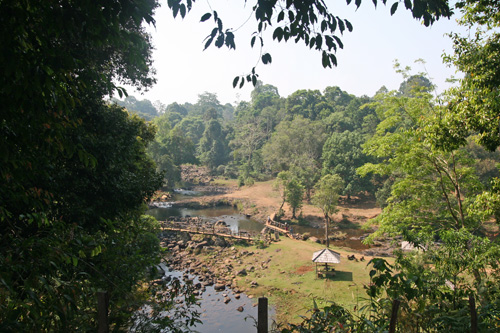
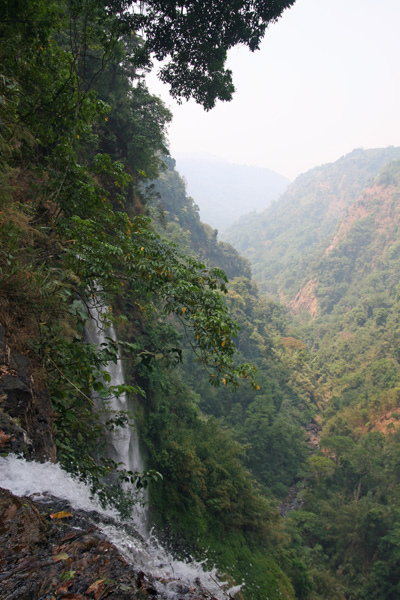
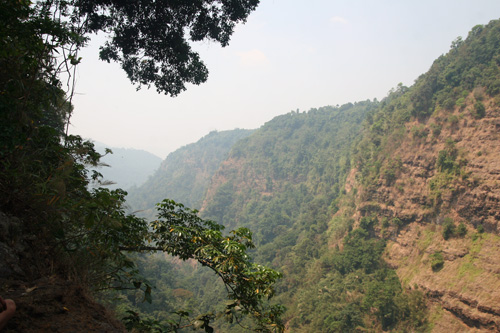







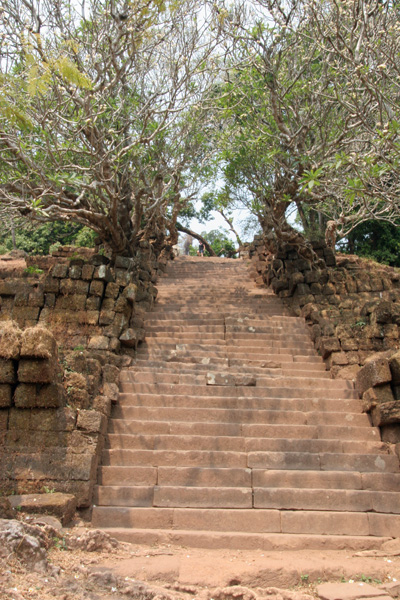
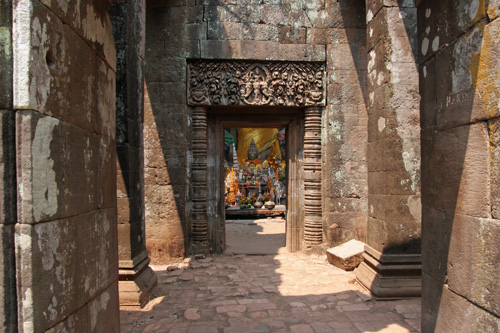
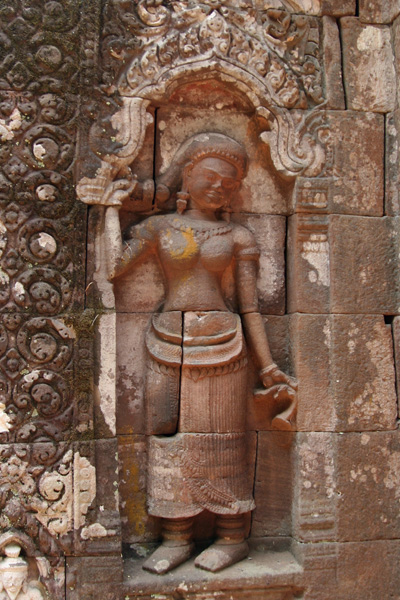
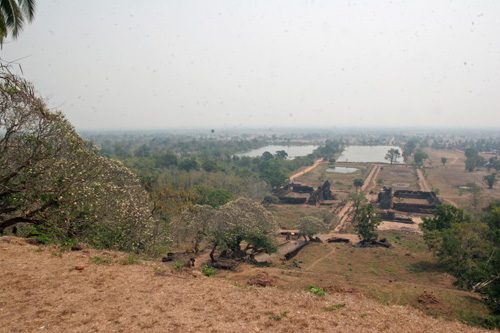
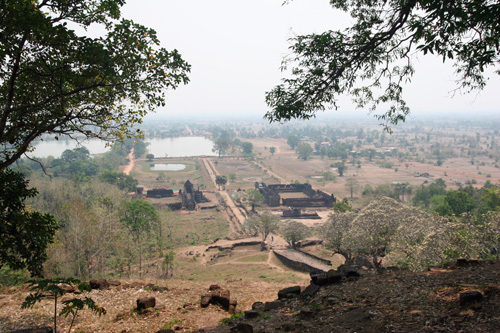
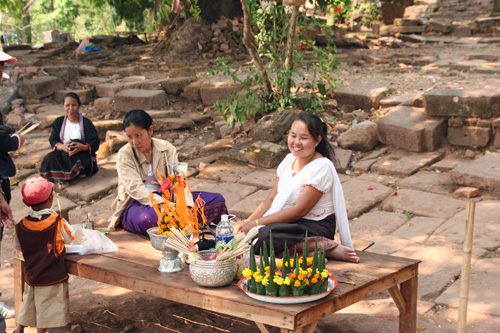
@pierreo.com I would have like to have visited those waterfalls … and then you showed the hike with more. I assume the climb was okay because you were on vacation and not in a hurry.